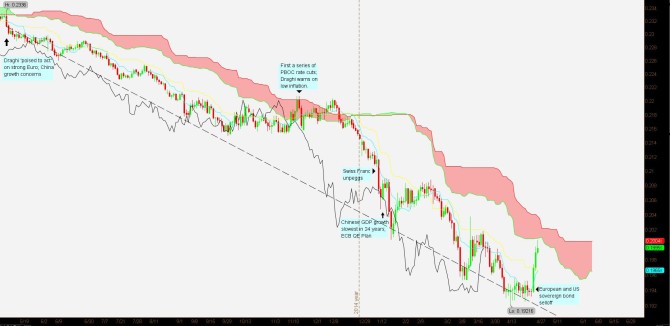Two seemingly unrelated economies are Singapore and Denmark. However, their currencies have been linked by a solidly negative trend. It is important to discover whether or not any direct economic link exists. If not, a trading opportunity exists.
The purpose of Monetary Authority of Singapore is to ‘promote sustained non-inflationary economic growth and a sound and progressive financial centre’. According to the MAS, the Singapore dollar is ‘managed against a basket of the currencies of their major trading partners’. Singapore’s European export partner weighting include: 1.7% for France; 2.0%, U.K.; 2.1%, Netherlands; 2.3%, Belgium-Luxembourg and 2.8 for Germany for a total of only 11% of exports.
Guest post by Mike Scrive of Accendo Markets
However, in the east China alone accounts for 14% of exports and the top 6 Asian trading partners total almost 59% of exports. Similarly, Europe accounts for only 11% of imports whereas the Pacific Rim trading partners account for almost 48% of imports. . Further, the MAS have an established special lending facility swap network with the PBOC and swap rate is a function of the Shanghai Interbank Offered Rate. The float is then mainly a trade-weighted function of the Chinese Yuan, Malaysia Dollar, Indonesia Rupiah, South Korea Won, United States Dollar, Japan Yen, and Hong Kong Dollar. It is far less influenced by Eurozone.
According to the “Recent Economic Developments Brief”, the Singaporean economy grew at a rate of 2.9% in 2014. The unemployment rate averaged a low 2.0%, full year, the Consumer Price Index expanded 1.0% and wages grew by 2.3%. To ‘gild the lily’, Singapore can boast per capita income of €74,312.00 a year. Singapore imports intermediate goods to turn around and export as valued-added products: 46% in machinery and equipment, 26% fuel, 13% chemicals. Trade deficits exit with the larger partners and surpluses with the smaller partners. Singapore’s economy is well balanced enough to absorb the impact of lower demand for petroleum exports.
Danmarks NationalBank’s (DNB) too, has a special currency agreement with its largest trading partner, the European Union. Denmark’s fixed exchange rate agreement, known as ERM2, is more rigorous than Singapore’s trade-weighted float. The fixed central exchange rate is 746.038 kroner per 100 Euro, restricted to a range of ±2.25% of the central rate. Otherwise, DNB conducts monetary policy by setting key interest rates under the hegemony of ERM2. It is important to make careful note of the ‘distribution of responsibility for economic policy. According to DNB: “… In a fixed-exchange-rate regime such as Denmark’s, monetary-policy interest rates are reserved for managing the exchange rate. The monetary-policy interest rates cannot also be used for managing the business cycle. Danmarks NationalBank’s monetary policy purely aims at keeping the krone stable against the euro…” It seems then although there is a bit of flexibility in policy, the Krone is essentially a function of the Euro. Hence there is far less flexibility in the EUR/DKK relationship than with the relationship CNY/SGD.
Denmark’s Asian exports total 7%, nearly half of which are destined for China’s markets compared with the 50% of exports destined for European markets. Similarly Europe accounts for over 55% of what Danes import whereas China accounts for 6.9% of what Danes import. Some similarities exist with petroleum exports, but Singapore and Denmark are not competitors in this market.
| DKK/SGD | Price Location | Span A below Span B | Trend Line Support | Tenkan vs Kijun | Sentiment |
| Trend Negative | Below Cloud | Resistance at 0.2006 | 0.1922 | Turning Bullish | Neutral to Negative |
After a long uptrend, the two year high occurred May of 2014 and then reversed. The reversal coincides precisely with the dual events of the ECB being concerned that a too strong Euro was stifling growth and a larger global concerns of China’s continued slowing of growth. The trend line demonstrates a clear line of support over the period from the 52 week high to 52 week low. This seems to indicate more a weakening of the Euro, thus affecting DKK, than a strengthening of the Yuan, thus affecting SGD, as most analysts considered China’s slowing economy as temporary. This is reflected from the May 2014 high of 0.2336 SGD per Krone to the April 2015 low of 0.1965 SGD per Krone; an almost 15.9% reduction. Along the trend line were several tests of both support and resistance. Three notable events occurred during the period from 15 January through 22 January: the Swiss surprise unpegging, record lows measured Chinese GDP growth and the ECB announcement of the promised QE program. The most recent run at testing cloud resistance may be related to the sudden and yet to be explained selloff in the US sovereign bond markets which, in turn, strengthened the Euro.
In conclusion, the expectation should be that it will be difficult for DKK/SGD to break through resistance as long as the ECB is still in the market and the US maintains its rate policy past June. Further, in the event of a recovery in the Eurozone the Danish Krone remains tied to the Euro while the MAS has the flexibility to manage its trade weighted dollar in response to a recovery in the Pacific region. Hence the Singaporean dollar should continue to lead the Danish Krone.
“CFDs, spread betting and FX can result in losses exceeding your initial deposit. They are not suitable for everyone, so please ensure you understand the risks. Seek independent financial advice if necessary. Nothing in this article should be considered a personal recommendation. It does not account for your personal circumstances or appetite for risk.”

